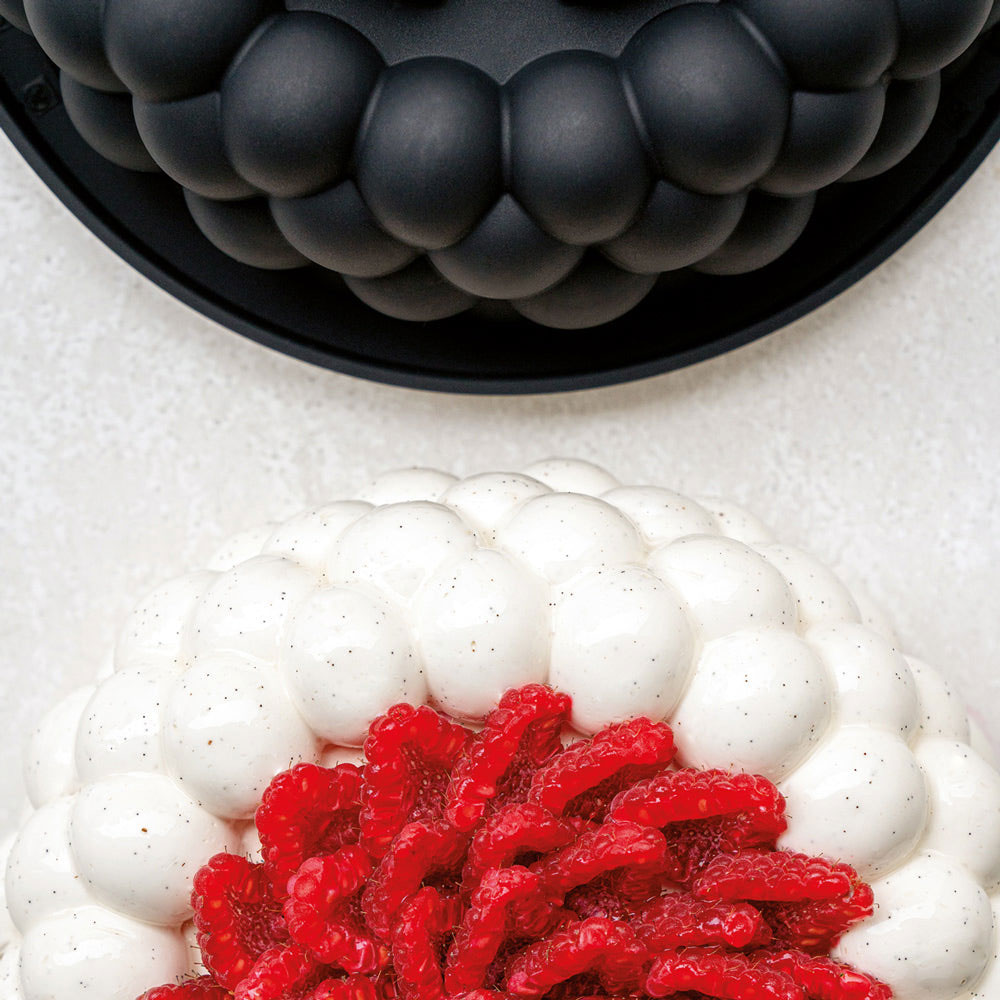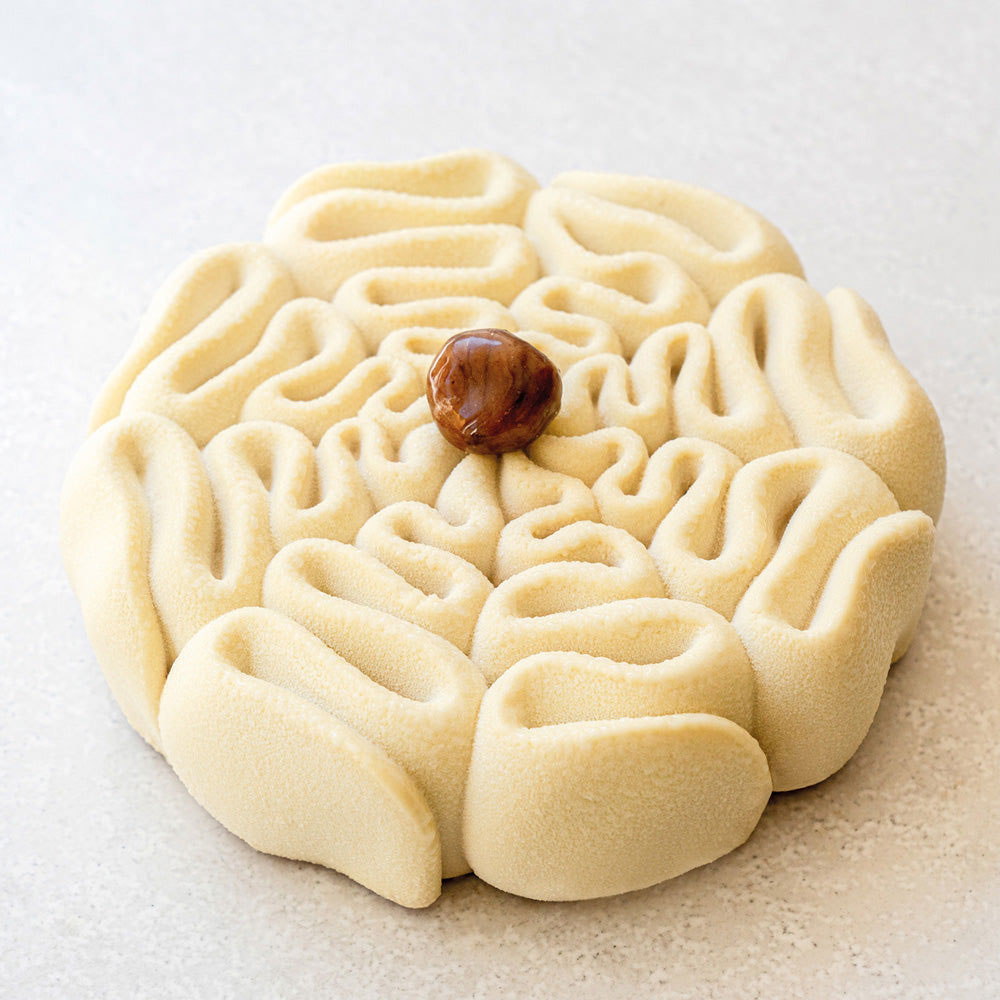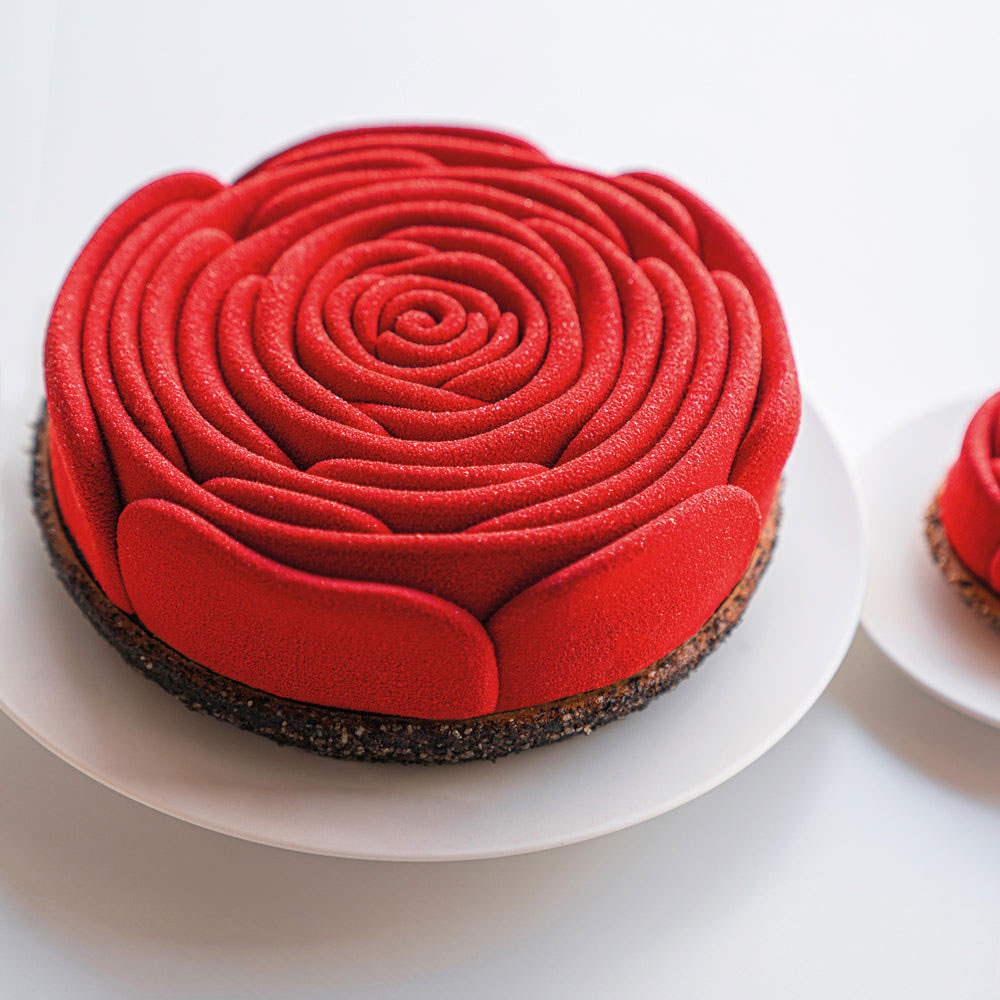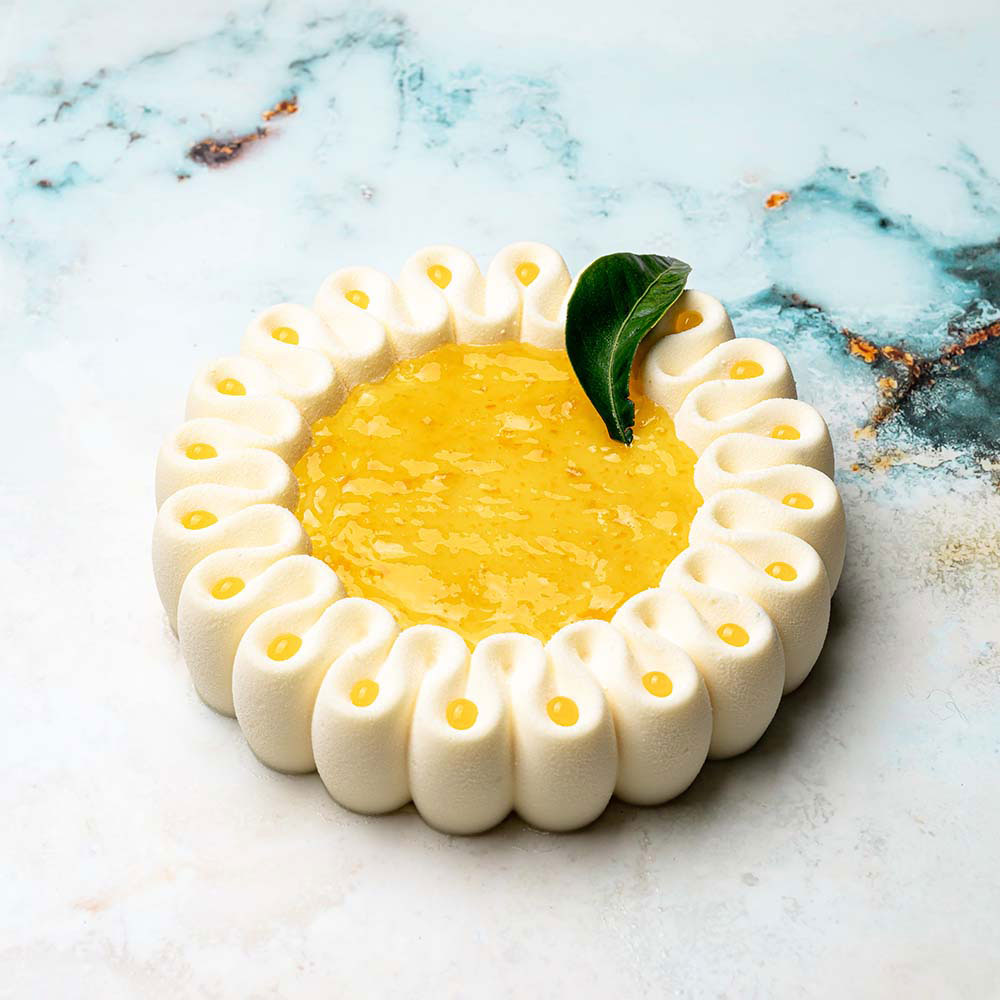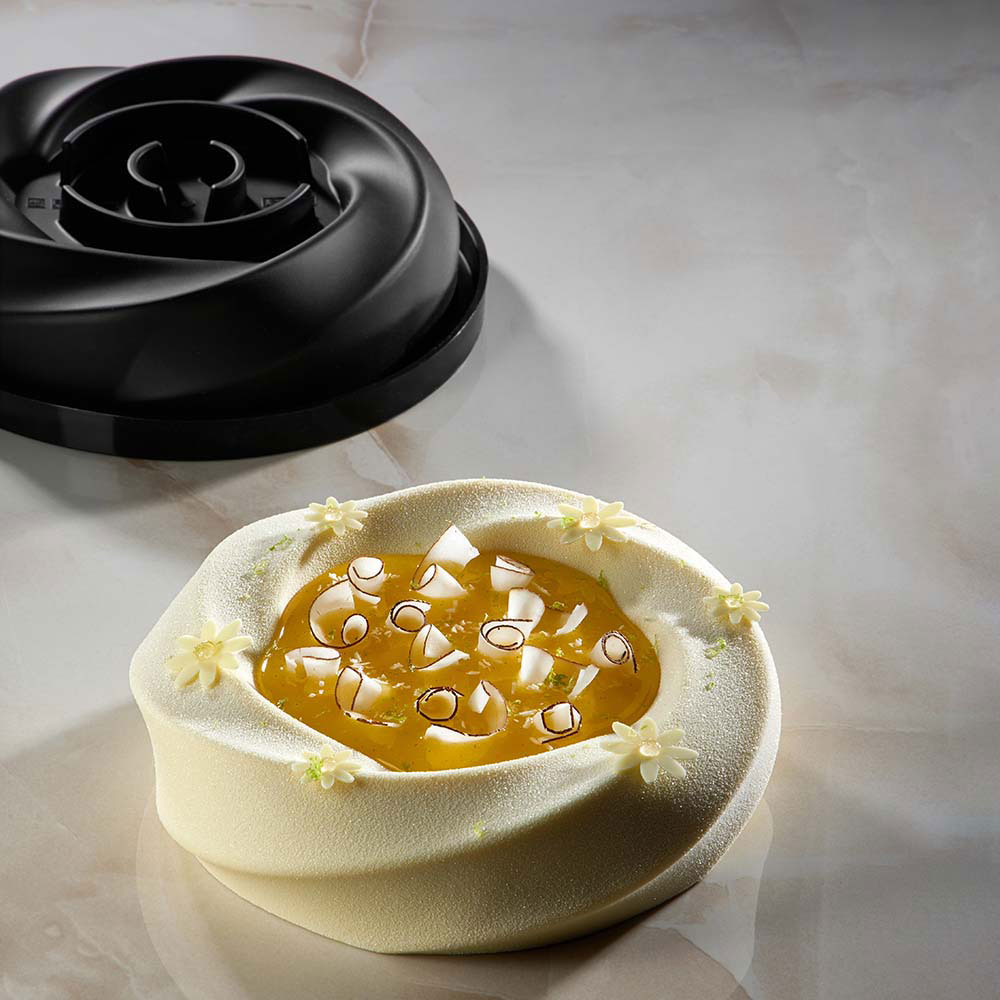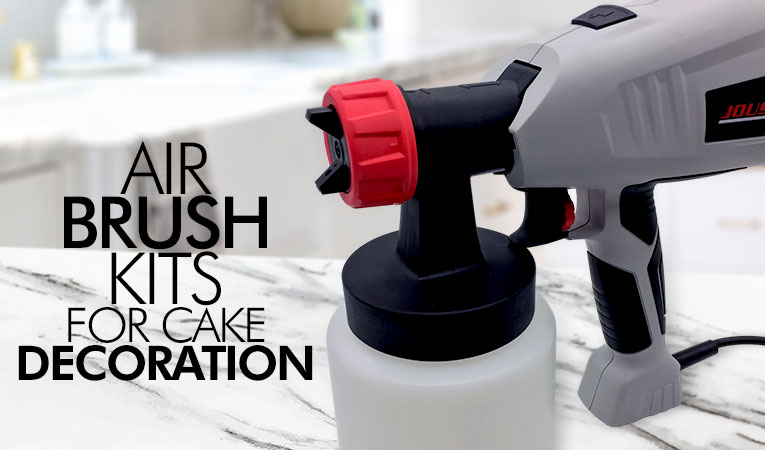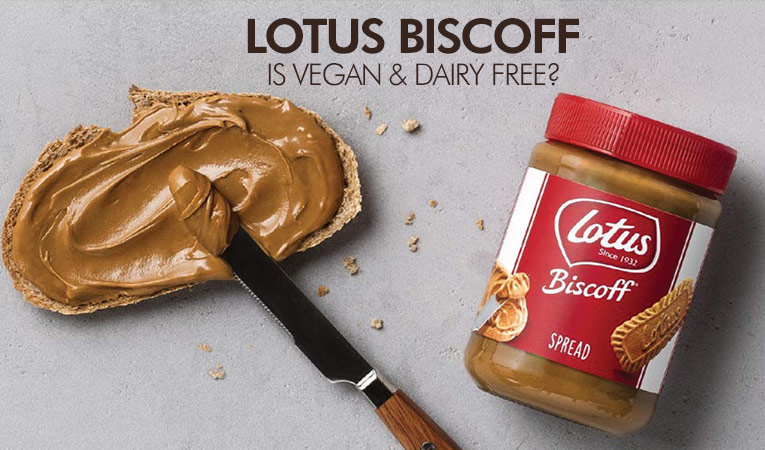Entremet Moulds for Cake: Create Stunning Layers with Ease
25-07-2025
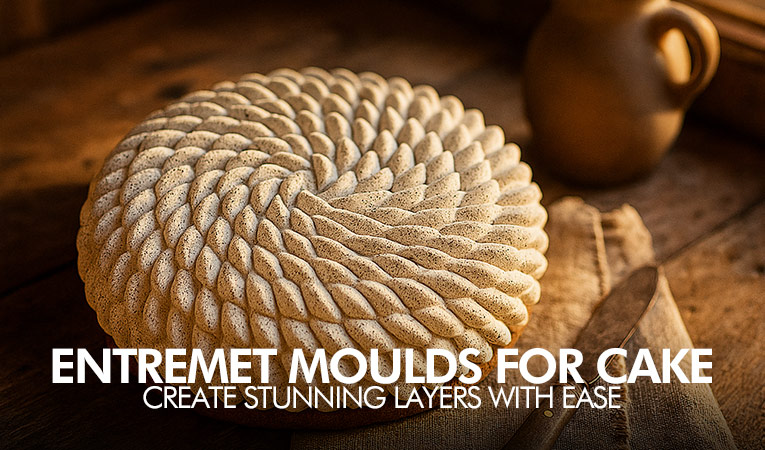
Entremet moulds for cake are transforming the way professional chefs and passionate bakers approach modern pastry. These moulds go beyond structure. They influence how each dessert is crafted, layered, finished, and ultimately experienced. Whether you are creating a single-serve dome or a sculpted mousse centerpiece, the mould you choose plays a significant role in the outcome. It determines not just the shape but also the clarity of layering, smoothness of finishes, and consistency of results.
Silicone moulds have become the preferred choice for making entremets because of their flexibility, non-stick surface, and ability to handle both freezing and baking. They help simplify complex builds by supporting inserts, mousses, sponge bases, and glazes all within a single form. For chefs aiming to streamline production while maintaining a high standard of design and presentation, these moulds offer unmatched value. From timeless round domes to geometric sculptures, the variety of shapes opens the door to creativity and innovation in every bite.
In this blog, we will explore different types of entremet moulds for cake, guide you through plating and finishing ideas, and help you choose the right mould based on your workflow and aesthetic preferences. We will also share expert care tips and sustainable tool pairings that align with eco-conscious kitchen practices. At Bakerykart, our curated range of professional-grade moulds is trusted by chefs across India who value precision, durability, and versatility.
Whether you are refining your signature dessert or expanding your pastry menu, the right entremet mould can take your creations to the next level. This guide is here to inspire, inform, and equip you with everything you need to work confidently with moulds that meet the demands of both creativity and performance.
What is an Entremet and Why Does Mould Matter?
An entremet is a beautifully layered dessert that brings together multiple textures and flavours in a single slice. It typically includes mousse, sponge, glaze, fruit inserts, and crunch layers, all structured to create a visually refined treat. What makes an entremet different from a regular cake is not only its composition but the precision it demands in preparation and presentation. To achieve that level of detail, every layer needs to be placed with care, and the mould becomes a crucial part of the process.
The mould is more than just a container. It is the foundation that holds the layers in place, defines the shape of the dessert, and enables clean, smooth demoulding. A good quality mould helps prevent distortion during freezing or baking and ensures that every edge and curve of the dessert remains intact. Whether you are working with a classic round entremet or an intricate geometric form, the mould gives you control over the outcome.
Silicone entremet moulds are especially preferred by professionals because of their flexibility and non-stick surface. These moulds allow for easy layering without the need for lining or greasing. Once frozen, the dessert can be effortlessly removed without cracks or smudges. This clean release is essential when working with mirror glaze or velvety textures that require a perfect exterior finish. The material also tolerates a wide range of temperatures, making it suitable for both hot and cold preparations.
Choosing the right mould plays a major role in how your entremet will look and hold up from preparation to plating. Whether you want to create tall individual portions or a centerpiece dessert for display, the mould allows you to maintain uniformity across batches. It also reduces waste and saves time in the finishing stages, especially when consistency is important in a commercial bakery setup.
Understanding what an entremet is and how the mould contributes to its structure helps you approach the dessert with confidence. A well-selected mould can enhance your technique, bring clarity to your layers, and result in desserts that are as precise as they are delicious. From rounded domes to elegant bars and sculpted shapes, each style begins with a mould that supports your creativity.
Types of Entremet Moulds for Cake
Choosing the right entremet mould is not only about shape. It is about how the mould supports your design goals, entremet cake recipe complexity, and plating style. Every type of entremet mould brings a unique aesthetic to the dessert. From classic domes to artistic waves, these moulds allow chefs to explore creativity without compromising structure or quality. Knowing your options helps you plan desserts that are visually impressive and professionally crafted.
-
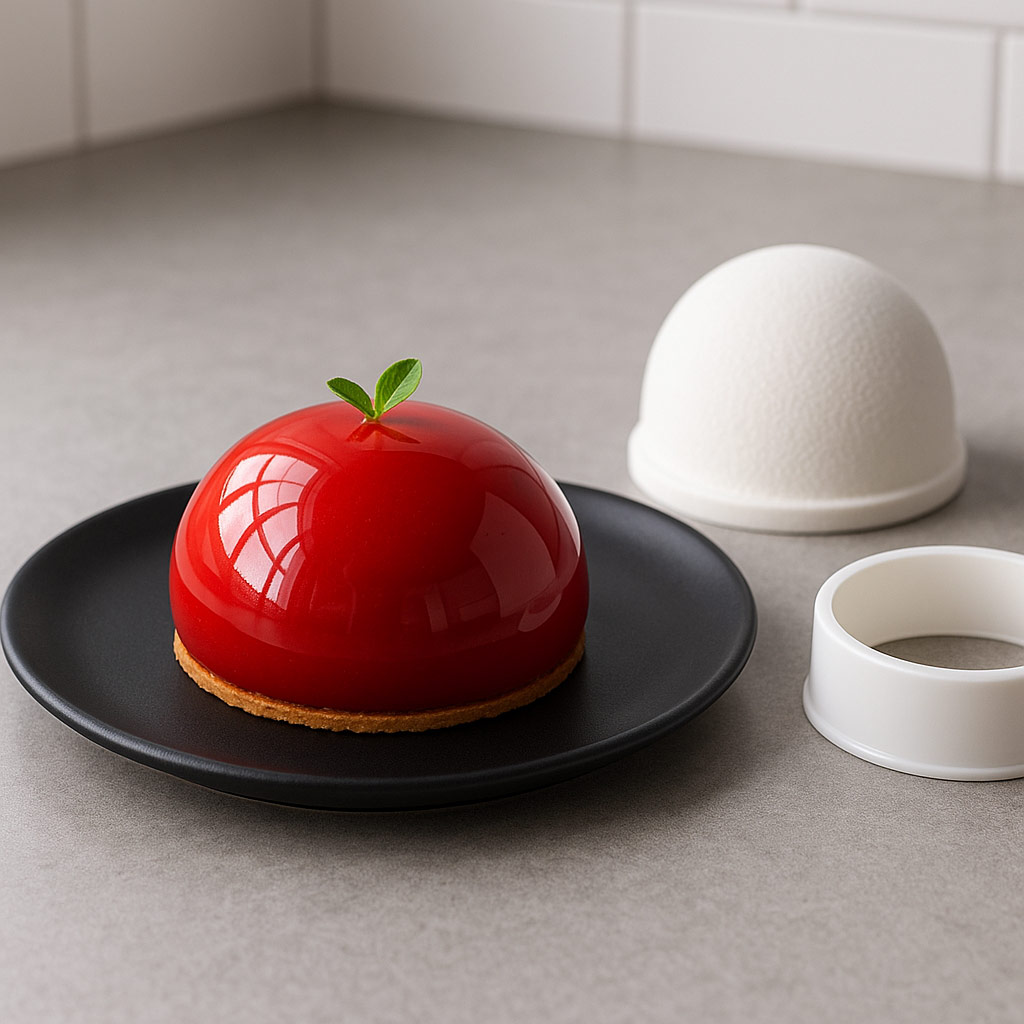
Classic Round and Dome Moulds
Classic round and dome moulds are timeless essentials for creating clean, elegant desserts. Their smooth curves and symmetrical form are perfect for showcasing mirror glazes or velvet finishes. Round moulds suit both full-sized cakes and individual portions, offering design flexibility with a refined look. Domes are especially favored for their ability to reflect light and highlight subtle surface textures.
-
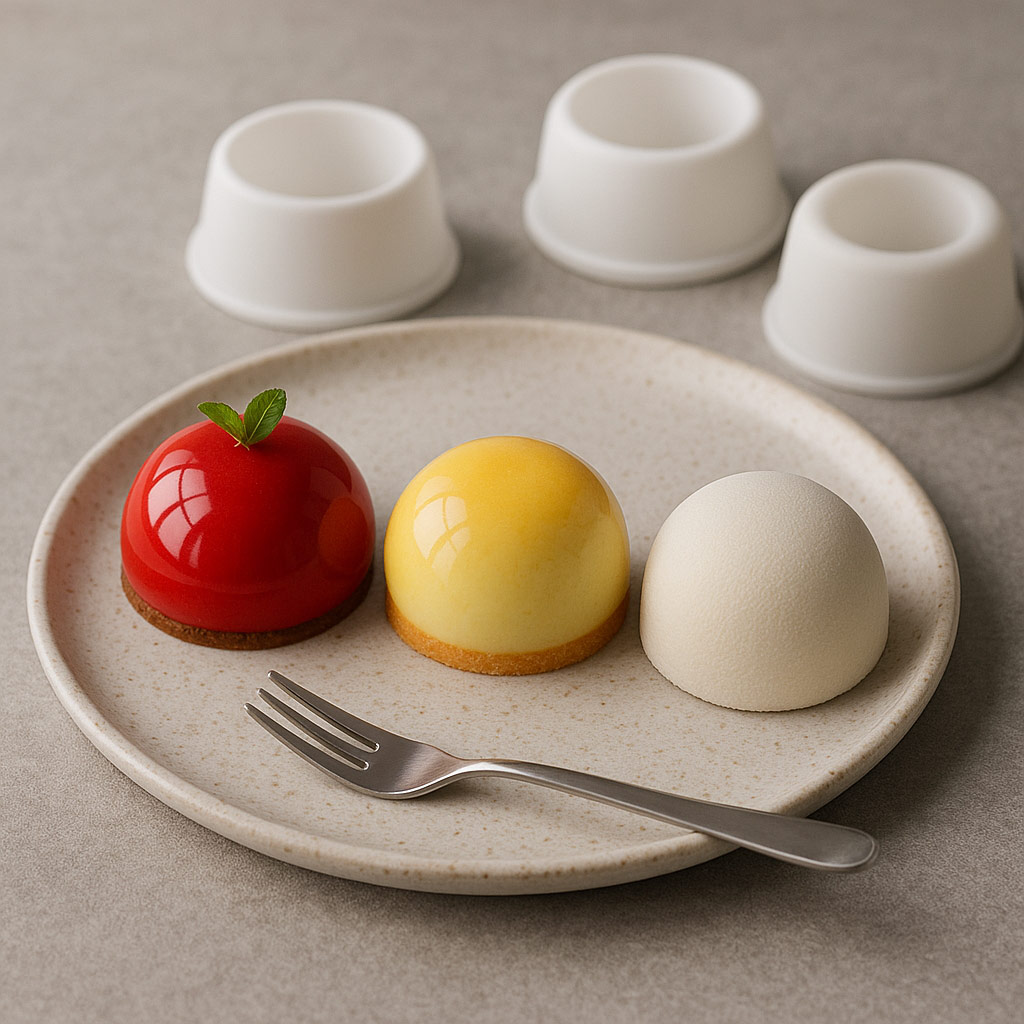
Mini Individual Moulds
Mini entremet moulds are ideal for chefs who want to serve desserts as part of a tasting menu or à la carte offering. These compact formats allow precise portioning and easy plating while speeding up freezing and production. Mini moulds encourage experimentation, helping you present multiple flavour profiles in one service with efficiency and consistency.
-
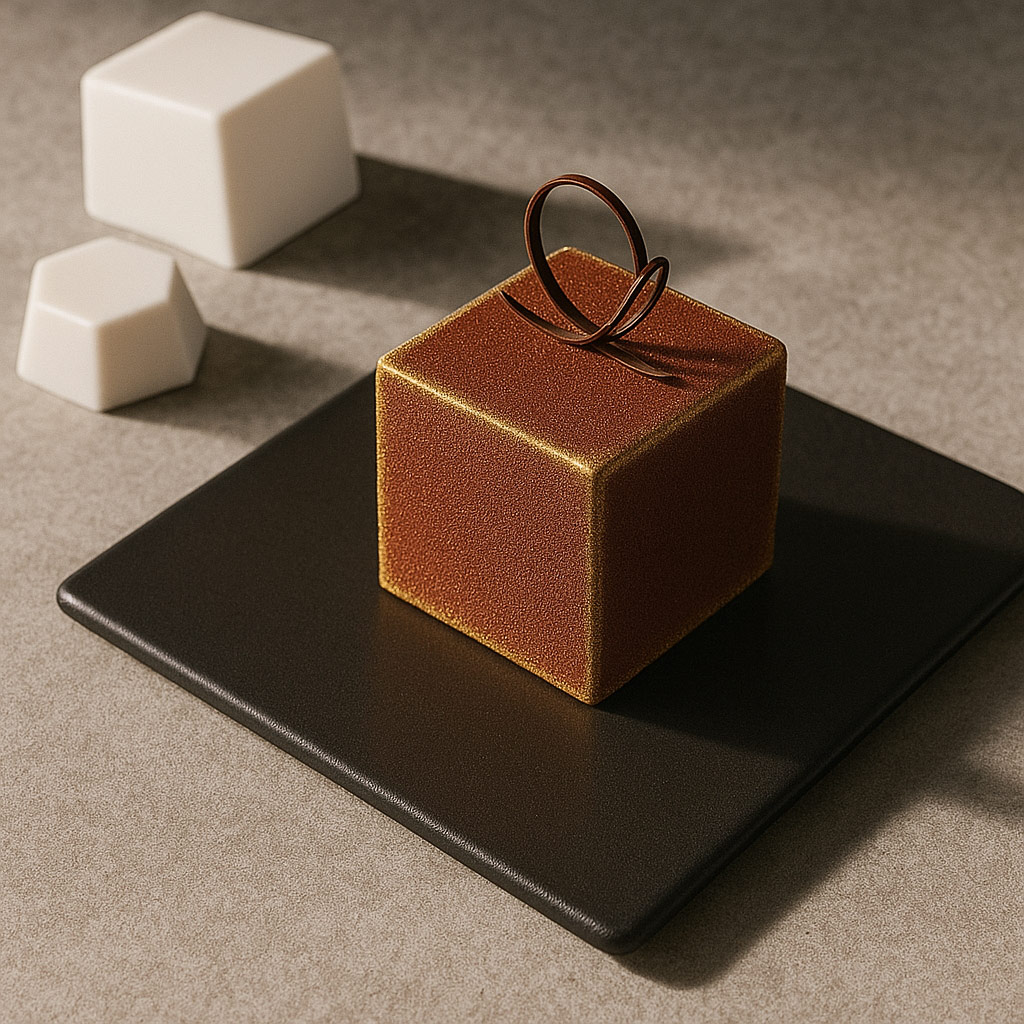
Geometric and 3D Moulds
Geometric and 3D moulds introduce a bold, modern aesthetic to dessert presentation. These shapes include cubes, diamonds, spheres, and undulating waves that add structure and drama. They are perfect for highlighting textures, especially when combined with velvet sprays, metallic dust, or chocolate accents. These moulds help transform pastry into sculpture while maintaining professional standards.
-
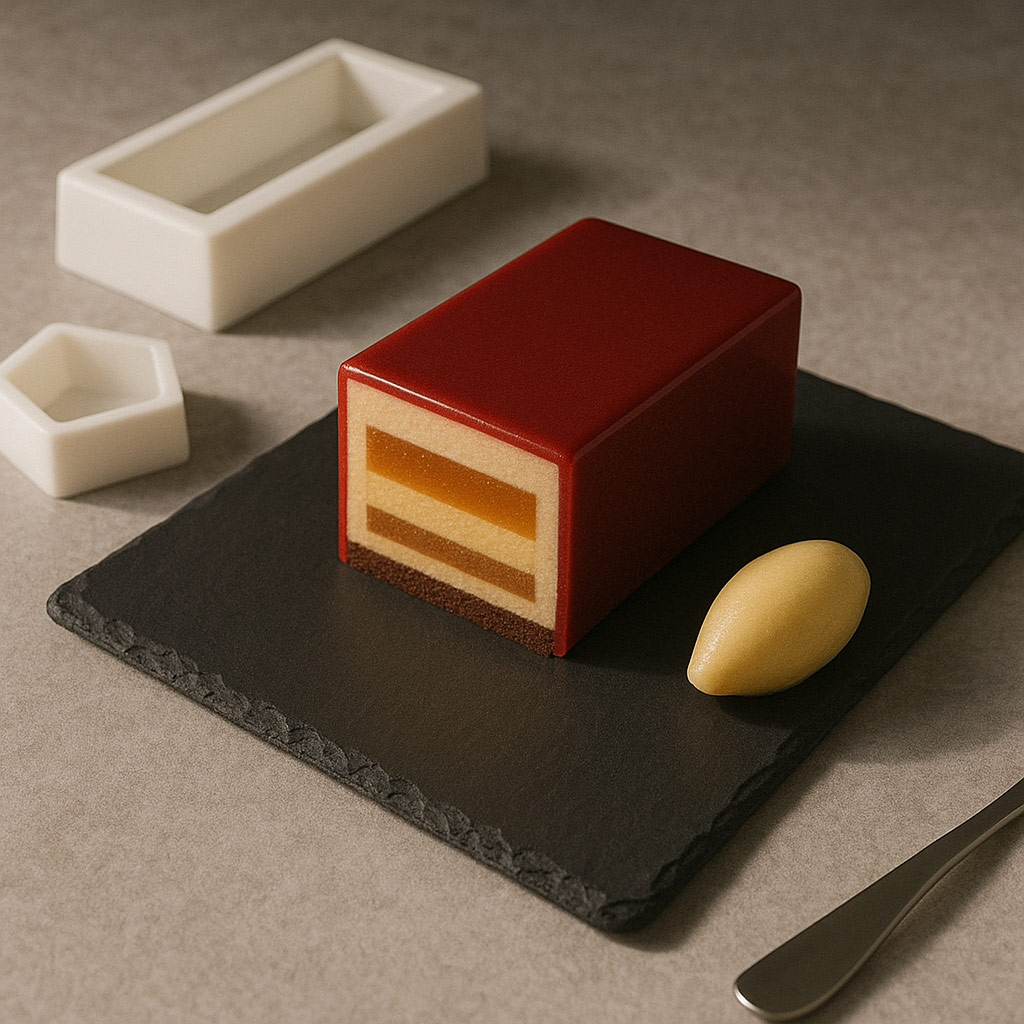
Bar and Insert Moulds
Bar and insert moulds are perfect for creating refined, layered entremets that reveal stunning cross-sections when sliced. Their rectangular shape supports log cakes and modern desserts with clean, defined lines. Insert moulds are often used to freeze ganache, compote, or jelly cores that are later embedded into the main structure, adding both visual contrast and flavour complexity.
-
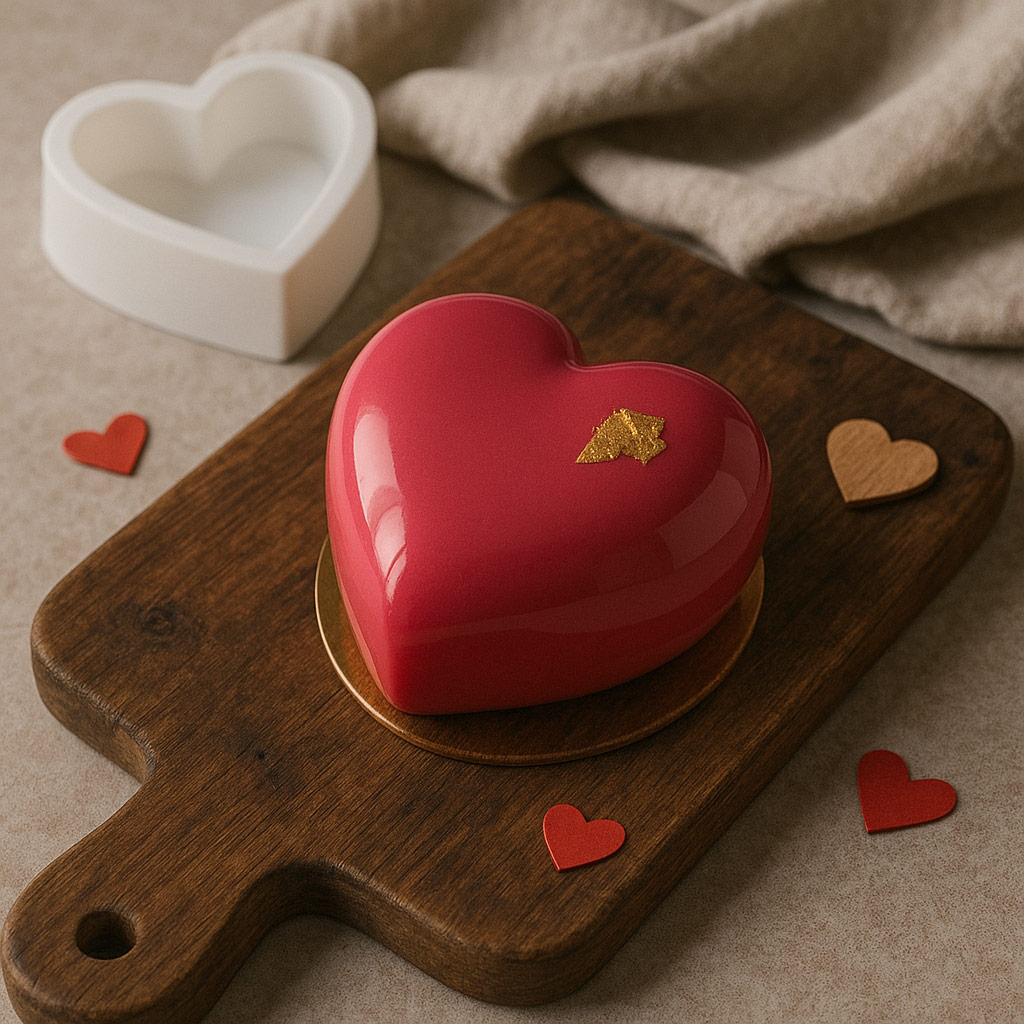
Holiday and Themed Moulds
Holiday and themed moulds bring storytelling to your desserts. Whether shaped like hearts, stars, or trees, these moulds are popular for festive menus, special events, or limited-edition offerings. They blend novelty with precision and are often used by chefs to deliver desserts that are both playful and professional, adding emotional appeal to every creation.
Each type of mould serves a unique purpose and helps bring dessert concepts to life. Selecting the right format based on portion size, complexity, and finish ensures that the final outcome looks and tastes as intended. Investing in a mix of these moulds also allows you to build a versatile pastry toolkit that adapts to different menus and customer preferences.
How to Choose the Right Entremet Mould
Choosing the right entremet mould is like selecting the perfect canvas for your dessert. It sets the foundation for your creativity, influences texture and layering, and determines how your final presentation will be received. With endless shapes, sizes, and styles available, the decision may seem overwhelming at first, but asking the right questions makes all the difference. A thoughtful choice not only enhances the look of your entremet but also improves consistency, workflow, and efficiency in any professional or home baking setup.
Whether you are curating a plated dessert menu or preparing for a special event, the right mould helps your dessert hold its shape, slice cleanly, and impress your guests from the very first look. Moulds are not just tools. They are an extension of your craft, helping you bring out the best in your flavours, textures, and design.
When selecting an entremet mould for cake, keep these key points in mind:
- Choose a shape that supports your dessert’s final look and desired finish
- Consider the number of servings needed for each batch or service
- Confirm that the mould is made from food-grade silicone suitable for freezing and baking
- If your dessert includes inserts, check that the mould allows proper layering and centering
- Opt for designs that support clean slicing and elegant plating
- Think about how well the mould fits into your daily prep routine and overall kitchen flow
- Ensure it is durable, easy to clean, and built for long-term professional use
- Match the mould’s size to your blast chiller or freezer trays to maximise space
- Choose options that align with your signature aesthetic or brand identity
- Plan for seasonal variations by keeping both classic and creative moulds in your toolkit
Your mould choice can elevate an entremet from simple to stunning. By taking a moment to align your mould with your vision, production needs, and style preferences, you gain more than just a beautiful shape. You gain confidence that every dessert leaving your kitchen will carry your creative fingerprint with consistency and finesse.
Behind the Scenes: Making the Perfect Entremet
Creating an entremet is a rewarding process that brings together precision, creativity, and patience. Every element must be thoughtfully prepared and layered with care to achieve a dessert that is not only visually stunning but also balanced in taste and texture. Whether you are crafting a single-serve mousse or a full-size entremet cake, the mould plays a central role in helping you bring structure and elegance to every layer. A well-designed silicone entremet mould for cake gives you the confidence to build, chill, and demould without compromising on form or finish.
The key to a successful entremet lies in preparation. Every step in the process should be planned in advance, especially when working with multiple components like sponges, jellies, mousses, and inserts. Timing, temperature, and technique must align to ensure a clean final result. It is not about speed. It is about flow. Once you get into the rhythm, building entremets becomes a creative journey where structure meets artistry.
Here is a step-by-step look at how professionals use silicone entremet moulds to build a flawless dessert:
- Begin by preparing your insert, which could be a fruit jelly, ganache, or custard layer, and freeze it in a smaller mould
- Prepare your sponge or biscuit base and cut it to size so it fits neatly inside the main mould
- Fill the mould partway with mousse and gently place the frozen insert in the center, pressing slightly to embed it
- Add additional mousse to fill the mould completely, tapping lightly to release any air bubbles
- Seal with the sponge base on top and press gently to level the surface
- Freeze the entire assembly until it is completely solid, usually overnight, to allow clean demoulding
- Once frozen, carefully peel back the silicone to release the dessert, ensuring the surface remains smooth and intact
- Apply your finish, such as mirror glaze, velvet spray, or ganache, depending on your recipe and design
- Plate the entremet with decorative elements like chocolate shards, gold leaf, or fruit pearls for visual impact
The perfect entremet is a balance of thoughtful construction and technical finesse. With the right mould, you can work confidently through each stage and bring clarity to your final design. Whether you are working with classic flavour profiles or experimenting with bold combinations, mastering the build process allows your desserts to shine both in structure and in style.
Top-Selling Entremet Moulds on Bakerykart
When it comes to choosing professional-quality entremet moulds for cake, selecting the right design can elevate both your technique and presentation. At Bakerykart, we curate premium silicone moulds from leading brands like Pavoni to support chefs who value precision, ease of use, and visual flair. Below are ten of our top-selling entremet moulds, trusted by professionals for their durability, design clarity, and flawless demoulding.
-
Nuage KE088S Cake Mould - Pavoni
This cloud-inspired silicone entremet mould from Pavoni helps you craft elegant and airy desserts with smooth curves and flowing lines. Its soft wave structure supports both mousse and layered sponge textures. Ideal for mirror glazes or velvet finishes, it allows you to demould cleanly and consistently. Designed for both freezing and baking, this mould brings flexibility, durability, and professional finesse to your entremet cake creations.
-
Dentelle KE082S Cake Mould - Pavoni
This artistic silicone entremet mould is crafted to resemble delicate lace folds. The intricate detailing of the Dentelle KE082S mould creates a dynamic visual on the surface of your cake, making it a favorite among pastry chefs looking for texture and elegance. Whether coated with glaze or velvet spray, the pattern remains beautifully intact after demoulding. It is perfect for celebrations, plated desserts, and professional pastry displays.
-
La Vie en Rose KE080S Cake Mould
Designed for romance and refinement, the La Vie en Rose KE080S mould features petal-like curves that unfold around your dessert. The silicone material captures every detail for a floral-inspired finish that holds beautifully through freezing or baking. It is ideal for special occasions, Valentine’s Day menus, and signature mousse cakes. This mould gives your entremet cake a soft yet sculpted presentation that guests will remember.
-
Ondulation KE101S Cake Mould - Pavoni
This mould offers a dynamic wave structure that brings movement and modern elegance to your dessert presentation. The Ondulation KE101S is designed for smooth layering and easy unmoulding. Its wide base and high-definition texture make it perfect for mirror glazes, while its curved lines enhance the visual rhythm on the plate. It is a versatile choice for chefs who love bold, contemporary pastry design.
-
Karma KE103S Cake Mould - Pavoni
The Karma KE103S mould features a radiating spiral design that symbolises harmony and balance. With its clean lines and smooth curves, this mould delivers a unique yet controlled form perfect for refined dessert plating. Made from food-safe silicone, it supports baking and freezing applications, allowing for creative flexibility in texture and flavour pairing. Ideal for chefs looking to make a meaningful visual statement with their entremet creations.
Each of these silicone entremet moulds combines artistry with precision, helping you shape desserts that look as flawless as they taste. From romantic floral curves to bold geometric waves, our top-selling collection is curated to meet the expectations of professionals who value design, quality, and performance. Explore the full range of Pavoni entremet moulds on Bakerykart and bring your pastry creations to life with tools trusted by chefs around the world.
Caring for Your Silicone Entremet Moulds
Silicone entremet moulds for cake are an essential investment for any professional kitchen. With proper care, they offer years of reliable performance and consistent results. From perfect demoulding to detailed texture retention, these moulds work best when maintained correctly. Taking the time to clean and store them properly ensures their shape, non-stick properties, and safety stay intact through every use. Good maintenance not only preserves their quality but also supports hygienic practices in your bakery or pastry studio.
Unlike metal pans, silicone moulds are flexible and require gentle handling. Excess heat, sharp tools, or harsh detergents can reduce their effectiveness over time. It is important to follow best practices after each use so the moulds continue to perform as expected. Whether you use your moulds daily in production or occasionally for specialty desserts, consistency in care will extend their usability and prevent common issues like tearing, staining, or surface dulling.
Follow these steps to keep your silicone entremet moulds in excellent condition:
- Always allow the mould to cool before cleaning, especially after baking
- Wash with warm water and a mild, non-abrasive soap using a soft sponge
- Avoid using sharp objects or metal utensils that may cut or pierce the silicone
- Rinse thoroughly to remove all traces of food and detergent
- Let the mould air-dry completely or use a lint-free cloth before storing
- Store the mould flat or in its original shape to prevent distortion or creasing
- Keep the mould away from direct sunlight and heat sources when not in use
- Do not apply cooking sprays or oils unless required by the recipe, as residue may build over time
- Use only food-grade sanitizers if disinfection is necessary for commercial use
- Regularly inspect your mould for signs of wear, and replace if cracks or deformation are visible
Caring for your silicone moulds is part of being a professional. With a simple cleaning routine and mindful storage, you can maintain the performance and appearance of your tools for hundreds of uses. A clean, well-kept mould also ensures that every entremet cake looks as polished and professional as the one before it. Take care of your tools, and they will continue to support your pastry success day after day.
Pairing Entremet Moulds with Natural Baking Tools
While silicone entremet moulds for cake bring precision and artistry to your plated desserts, pairing them with natural baking tools enhances both your process and presentation. The materials you use in your kitchen speak to your values as a baker. By combining high-performance moulds with eco-conscious tools, you create a workspace that is not only efficient but also mindful of sustainability and long-term impact. This thoughtful pairing elevates your workflow while supporting environmentally responsible choices in your kitchen.
Natural baking tools are not just about aesthetics. They offer practical benefits such as breathability, durability, and timeless design. Tools like cane banneton baskets, wooden breadboards, and compostable piping bags reduce waste and offer reusable alternatives to plastic-heavy options. When paired with silicone moulds, these tools round out a chef’s toolkit with a balance of innovation and tradition. They also add rustic charm and artisan character to your finished presentation.
Here are some ways to pair silicone entremet moulds with natural, sustainable baking tools:
- Use natural cane banneton baskets for proofing doughs that complement your dessert offerings
- Present sliced entremets on wooden serving boards or reclaimed wood platters
- Apply finishes using natural bristle brushes or bamboo-handled pastry tools
- Pipe fillings with compostable or reusable piping bags to reduce single-use plastic
- Dust flour or cocoa with wooden sifters for a consistent and gentle touch
- Store inserts or baked bases in natural cotton-lined containers or breathable covers
- Incorporate linen kitchen towels when handling delicate desserts for a soft, professional touch
- Serve individual portions alongside natural ceramic ramekins or stoneware bases
- Avoid plastic cloches and choose glass or wood domes when showcasing plated desserts
- Keep a separate section of your kitchen outfitted with eco-friendly tools for sustainable prep and plating
Pairing modern silicone with natural materials creates a meaningful contrast that highlights your creativity and values. This blend of function and sustainability resonates with customers who appreciate conscious craftsmanship. At Bakerykart, we believe that tools should support not just technique but also purpose. When you choose moulds and accessories that align with thoughtful baking, your kitchen becomes a space where innovation and responsibility work hand in hand.
Bonus - Chef-Approved Plating Ideas for Entremet Cakes
An entremet is not complete until it is plated with care and intention. The mould helps create structure, but plating brings emotion, contrast, and storytelling to your dessert. Every curve, texture, and colour deserves a thoughtful composition that enhances the visual experience. Whether you are presenting in a fine-dining restaurant or showcasing your desserts in a boutique bakery, plating is where technique meets presentation. It turns a layered creation into a piece of edible art.
Professional pastry chefs use plating as a form of expression. With the right elements, you can guide the diner’s eye across the plate, highlight textures, and complement the flavours of your entremet. From minimalist designs to bold arrangements, your approach to plating can define your brand’s identity and elevate customer perception. Using tools like garnish mats, chocolate décor, and microgreens adds contrast and elegance without overpowering the dessert.
Here are some chef-approved plating ideas to enhance your entremet cakes:
- Place the entremet off-center to create negative space and draw attention
- Use tempered chocolate shards, curls, or disks for added height and texture
- Add fruit pearls, coulis dots, or gel smears in complementary colours for visual contrast
- Highlight textures with powdered elements like freeze-dried fruits or edible soil
- Introduce crisp elements such as caramel tuile or cookie crumble for texture variation
- Layer sauces in thin lines or abstract brushstrokes to build depth and movement
- Use micro herbs or edible flowers to introduce freshness and natural colour
- Plate on matte or textured ceramic plates that contrast with the shine of your glaze
- Apply a velvet spray finish and dust with gold or bronze shimmer for a luxurious touch
- Add a quenelle of sorbet, mousse, or chantilly cream to balance flavour and enhance plating dynamics
Plating is not just a final step. It is an extension of the dessert’s story. With careful thought and creative flair, you can elevate each entremet from a structured mould to a plated memory that lingers long after the last bite. At Bakerykart, we support chefs not only with the tools to build but also with the inspiration to present with style.
Frequently Asked Questions
Choosing and working with entremet moulds for cake often leads to questions about technique, materials, and maintenance. Whether you are new to layered desserts or looking to refine your existing workflow, having clear answers can make a big difference. This section covers the most common queries chefs and bakers have about using silicone entremet moulds. Each answer is designed to help you make informed choices, improve your results, and care for your tools with confidence.
- What is the best silicone entremet mould for beginners?
For beginners, a round or dome-shaped silicone mould is ideal. These shapes are forgiving, easy to glaze, and demould without difficulty. They allow you to focus on layering and structure while building confidence with finishes and textures. - Can I use entremet moulds in the oven?
Yes, high-quality food-grade silicone moulds are oven-safe. They can withstand high temperatures and are suitable for baking sponges, inserts, or even cakes directly in the mould. Always check the manufacturer’s temperature rating before use. - Are all silicone moulds safe for food?
Not all silicone moulds are made equal. Look for moulds made with certified food-grade silicone. These are free from harmful fillers and designed to handle both freezing and heating without degrading or releasing chemicals. - How do I prevent air bubbles in mousse layers?
To avoid air bubbles, pour mousse slowly into the mould and tap it gently on the counter to release trapped air. You can also spread mousse with a palette knife to help fill corners and edges evenly. - Can I use the same mould for mousse, sponge, and jelly?
Yes, silicone moulds are versatile and suitable for multiple components. You can layer mousse, sponge, jelly, ganache, or inserts within the same mould. Just ensure each layer is set properly before adding the next. - How do I calculate the capacity of a mould?
To calculate volume, fill the mould with water and measure the quantity it holds. This helps you plan your recipe quantities accurately and avoid overfilling or wastage. - Do silicone moulds stain or hold odours over time?
High-quality silicone moulds resist staining and do not retain flavours or smells. However, it is best to wash them thoroughly after every use and avoid using strong-smelling ingredients in the same mould repeatedly. - How should I store silicone moulds to maintain their shape?
Always store silicone moulds flat or upright in their natural shape. Avoid folding or placing heavy items on top, as this can cause permanent creasing or warping over time. - What is the lifespan of a silicone entremet mould?
With proper care, a professional-grade silicone mould can last for hundreds of uses. Keep it clean, avoid sharp tools, and follow storage guidelines to maximise durability and performance. - Are silicone entremet moulds recyclable?
While not always recyclable through regular municipal programs, silicone moulds are reusable and long-lasting, making them a more sustainable option compared to single-use plastics. Many local recycling centers offer specialised disposal for silicone.
From selecting your first mould to mastering advanced techniques, these answers are here to support your journey. At Bakerykart, we are committed to offering tools that perform reliably and help you focus on the art of baking with confidence and creativity.
Final Thoughts
Entremet moulds for cake are more than just pastry tools. They are creative companions that help you turn technical precision into artistic expression. Whether you are crafting a velvety mousse, layering delicate inserts, or glazing your final masterpiece, the right mould gives your dessert structure, clarity, and elegance. It allows you to present your flavours with confidence and consistency, turning each plate into a reflection of your craft.
At Bakerykart, we understand the role that reliable tools play in a busy kitchen. That is why we curate professional-grade silicone entremet moulds that are trusted by pastry chefs, educators, and boutique bakers across India. Our collection supports a range of design styles, from minimal rounds to sculptural showpieces. We also offer natural baking accessories like banneton baskets, wooden boards, and sustainable piping solutions that align with your values while enhancing your workflow.
Choosing the perfect entremet mould is not just about shape or size. It is about finding a mould that fits the way you work, the stories you want to tell, and the standards you aim to maintain. With proper care and creative plating, a well-made silicone mould becomes a lasting part of your pastry journey.
We hope this guide has inspired you to explore new styles, techniques, and pairings. Whether you are starting with classic domes or experimenting with bold textures, we invite you to browse our curated selection and elevate your next dessert.
Have a favourite entremet mould or a plating trick that always impresses? Share your thoughts in the comments below. We would love to hear how you bring your entremet ideas to life. Your experiences may just inspire another chef in our growing Bakerykart community.



